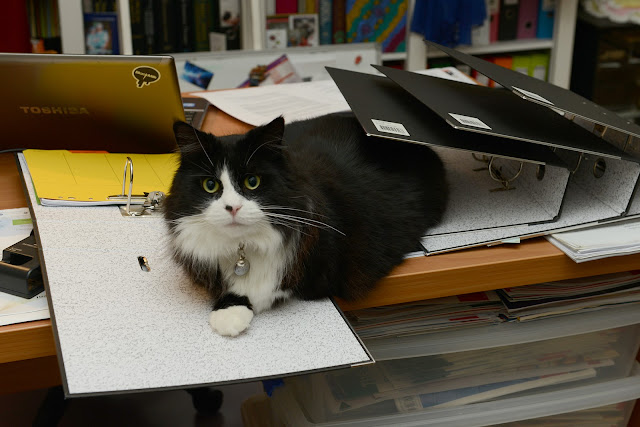 |
| Hero's plan is to sit ON memberships, as demonstrated by his rapid insertion of himself into folders I bought to organise the reading material. |
One of the aims of this blog is to promote the welfare of
companion animals. It seems so straightforward: companion animals are
companions, so don’t we look after them to the best of our ability?
The answer, in short, is not always. We’re people. We
get it wrong. One of the fields that has grown over the last fifty years in
particular is the science of animal welfare, and it has proven that
occasionally our intuitions about what is best for an animal aren’t always the
best thing. For example, when it comes to enclosures for guinea pigs, bigger is
not always better. They need adequate space, but they’re also thigmotactic –
they like to be wallflowers and the concept of a wide open space can be a bit
confronting and cause significant stress.
Similarly with reptiles. They need their space, but they
also need heat (more specifically, a heat gradient based on their preferred
optimal temperature zone), exposure to UV light, a hide, appropriate humidity
and so on). Sticking them in a big fancy enclosure might tick the space box,
but if the heating isn’t right the animal ends up severely immunocompromised.
As a companion animal veterinarian I deal mostly with the
welfare of individual animals (and their associated humans) on a daily basis.
But welfare is one of those things we can always do better. And our views about what is good animal welfare change over time, with the advent of new evidence and sometimes in spite of it.
So, with the encouragement of a fantastic colleague who
sold me when she said we could be study-buddies (years of study has taught me
that a good study-buddy is worth their weight in gold), I’ve made the decision
to sign up to sit membership examinations in animal welfare.
For those who don’t
know, memberships of the Australian and New Zealand College of VeterinaryScientists are exams one can sit (as long as one is at least three and a half
years out of vet school) that help one hone one’s knowledge in a particular
area. This is about the journey, not the destination. i.e. it’s about the
period of study and mentorship ahead of time that really count.
According to the ANZCVS -
"The candidate is expected to demonstrate a high level of interest and competence in a given area of veterinary activity. This is judged by that standard of knowledge and understanding, practical skills, attitude, methodology and communication which would make the person suitable to give professional advice to veterinary colleagues not similarly qualified on problems or procedures often encountered or used in general practice, in the relevant area of veterinary endeavour."
Every year, veterinarians from Australia and New Zealand sit
these formidable exams and many become members in the different college
chapters – from medicine and surgery to zookeeping and unusual and exotic pets
to pharmacology and pathology. (If you see a vet with the letters MANZCVS after
their name, it means they’ve sat memberships in one or more of these areas).
Candidates sit two written exams and an oral exam. In
animal welfare that means understanding not just the welfare of companion
animals, but issues pertaining to the welfare of all veterinary species,
including ethics and legislation. Not a small area.
So right now we’re in the mode of constructing a learning
plan, reading papers and planning. It won’t change the emphasis of SAT,
although I’m hoping to share more animal welfare information along the way.
If you’re keen to sit your memberships, the best source
of information is the ANZCVS Membership Candidate Handbook which you can
download free of charge here.
To get an understanding of the level of knowledge
required it is helpful to review past written exam papers, which can be viewed
here.
Our challenge is to take a balanced approach to life and study - and we'd love to hear from SAT readers about they approach big projects and exams.

